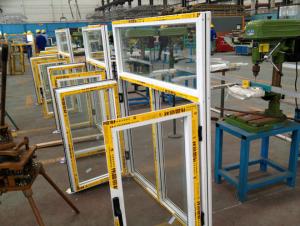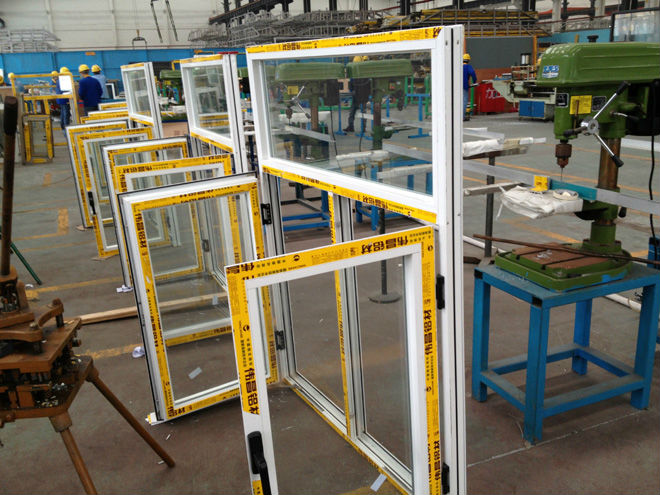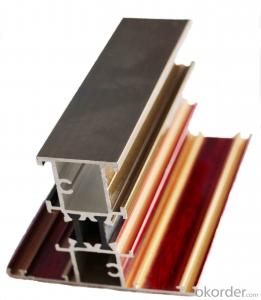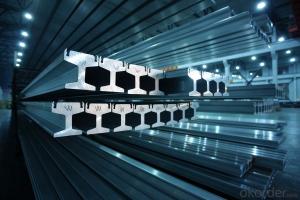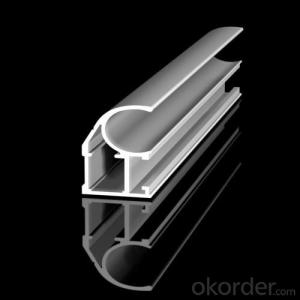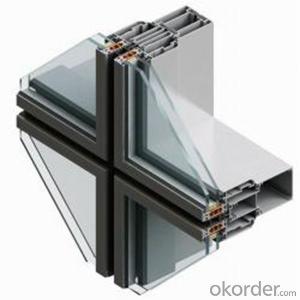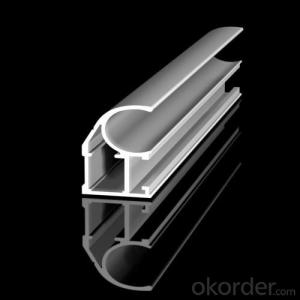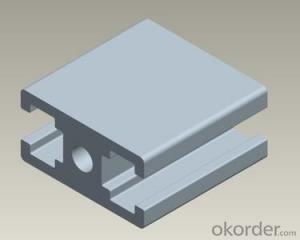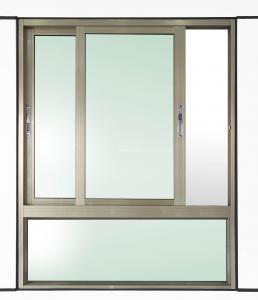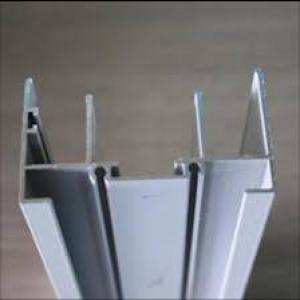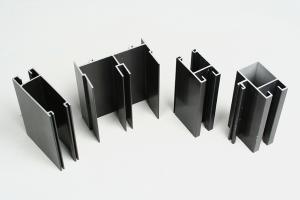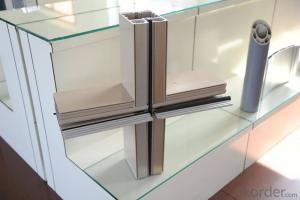Solidworks Aluminum Extrusion Profiles for Windows
- Loading Port:
- China Main Port
- Payment Terms:
- TT OR LC
- Min Order Qty:
- -
- Supply Capability:
- -
OKorder Service Pledge
OKorder Financial Service
You Might Also Like
Aluminium Profile
1)Material : 6063 6061 6060 and different aluminium alloy
2)Status:T4 T5 T6 or other special status
3)Surface treatment: mill finish, anodized sliver ,anodized bronze, anodized champagne, anodized black pearl, various power coating color, electrostatic sliver, electrostatic champagne, electrostatic golden, electrostatic titanium , machine polish sliver, machine polish bronze, wooden grain color, and Fluorocarbon spraying.
4)Annual capacity : 120000TON
5)Quality : China Nation Standard GB/T 5237 2008 (advanced class)
6)Use: can be widely using aluminium window, door, curtain wall, hand railing , normal aluminium profile, decorative and industrial aluminium profile
7)Advantage: Famous Brand reasonable&market price, soonest delivery and good after sale- service
8)Type of package:protection foam+heat contracted plastic film. / wooden packing / Metal pallet or depand on clientspecial requirement.
9)Payment term:T/T:30% of total value as deposite should paid by T/T within 3 days when confirmation ,and the remaining sum should be paid by T/T before delivery.L/C: 100% at sight
10)Delivery Day: 15-30days
11)Honor : CHINA FAMOUS TRADEMARK, CHINA TOP BRAND, ISO9001-2000, CHINA SQUARE&ROUND COMMITTEE DNV
- Q: Is it possible to utilize aluminum profiles in the construction or structure of commercial buildings and factories?
- <p>Yes, aluminum profiles are commonly used in commercial buildings and factories due to their strength, durability, and lightweight properties. They are ideal for constructing frameworks, window and door frames, and support structures. The corrosion resistance of aluminum also makes it suitable for industrial environments where exposure to harsh chemicals or weather conditions is a concern. Additionally, aluminum profiles are easy to maintain and can be recycled, contributing to the sustainability of construction projects.</p>
- Q: What are the different fastening options available for aluminum profiles?
- Various fastening options are available for aluminum profiles, depending on the specific application and desired functionality. Some commonly used options are: 1. Using screws is a popular method for fastening aluminum profiles. They are easy to install and provide a strong and secure connection. Self-tapping screws are often used as they create their own threads in the aluminum profile. 2. Bolts and nuts offer another reliable option for fastening aluminum profiles. They provide a strong connection and can be easily tightened or loosened as required. It is important to choose the appropriate size of bolts and nuts and ensure proper tightening to avoid stripping or loosening of the connection. 3. T-slot nuts are specifically designed for T-slot aluminum profiles, which have a groove along their length. T-slot nuts slide into the groove and can be easily positioned and tightened using a hex key. They offer a versatile and adjustable fastening option, allowing for easy repositioning or modification of the profile. 4. Clamps are commonly used to secure aluminum profiles together or attach other components to the profile. They come in different designs, such as corner clamps or angle clamps, and provide a quick and easy way to assemble or disassemble aluminum structures. 5. Adhesives can be used to bond aluminum profiles together, providing a clean and seamless appearance. However, the strength of the bond may vary depending on the adhesive and surface preparation. It is important to choose an adhesive specifically designed for aluminum and follow the manufacturer's instructions for proper application. 6. Welding is a permanent fastening option for aluminum profiles. It involves melting the aluminum material and fusing it together, creating a strong and durable connection. However, welding requires specialized equipment and skills, making it a more complex and time-consuming process. When selecting the appropriate fastening option for aluminum profiles, it is crucial to consider the specific requirements of the application, such as load-bearing capacity, adjustability, or disassembly needs. Consulting with experts or manufacturers can help in choosing the most suitable fastening method for a particular project.
- Q: Can aluminum profiles be used for framing mirrors?
- Indeed, mirrors can be framed using aluminum profiles. Aluminum, a lightweight and versatile material, lends a contemporary and polished appearance to any mirror frame. Its durability, resistance to corrosion, and simplicity in customization make it a favored choice in diverse industries such as architecture and interior design. With an array of shapes and finishes available, aluminum profiles provide limitless design options to suit various styles and decorations. Furthermore, the ease of installation and maintenance of aluminum frames further contributes to their popularity in both residential and commercial settings for framing mirrors.
- Q: Are aluminum profiles suitable for indoor applications with high humidity?
- Yes, aluminum profiles are suitable for indoor applications with high humidity. Aluminum is highly resistant to corrosion and does not rust, making it an ideal material for humid environments. Additionally, aluminum profiles can withstand moisture and humidity without warping or deteriorating, ensuring their durability and suitability for such conditions.
- Q: Do aluminum profiles require any special maintenance?
- Aluminum profiles do not require any special maintenance. Aluminum is a durable and low-maintenance material that is resistant to corrosion, rust, and weathering. Unlike other materials such as wood or steel, aluminum profiles do not need to be regularly painted, stained, or treated to maintain their appearance or functionality. Additionally, aluminum is lightweight, making it easy to handle and install. However, it is important to keep the aluminum profiles clean by regularly removing dirt or debris with a mild detergent and water solution. This will help to preserve the aesthetic appeal and longevity of the profiles. Overall, aluminum profiles are a convenient and hassle-free option for various applications, as they do not require any special maintenance.
- Q: Are aluminum profiles suitable for gym equipment?
- Yes, aluminum profiles are suitable for gym equipment. Aluminum is a lightweight and durable material that can withstand heavy use and provide excellent structural support. Its strength-to-weight ratio makes it ideal for gym equipment as it allows for easy maneuverability while still maintaining stability and durability. Additionally, aluminum is resistant to corrosion, making it suitable for environments with high humidity or moisture levels, such as gyms or fitness centers. The versatility of aluminum profiles also enables the customization of gym equipment to fit specific needs and requirements. Overall, aluminum profiles offer numerous benefits for gym equipment, making them a suitable choice for fitness facilities.
- Q: Do aluminum profiles come with any certifications?
- Yes, aluminum profiles often come with certifications such as the ISO 9001 quality management system certification, ISO 14001 environmental management system certification, and the RoHS (Restriction of Hazardous Substances) compliance certification. These certifications ensure that the aluminum profiles meet international standards for quality, environmental friendliness, and the absence of hazardous materials.
- Q: This question asks about the various types of fasteners that are used to secure aluminum profiles in construction projects.
- <p>In construction, several types of fasteners are used to secure aluminum profiles. These include: 1. Bolts and Nuts: Commonly used for joining aluminum profiles, they provide a strong and secure connection. 2. Rivets: These are used for permanent connections and are ideal for load-bearing applications. 3. Screws: Self-tapping screws are often used for joining aluminum profiles without the need for pre-drilling. 4. Adhesives: Structural adhesives can be used for bonding aluminum profiles together, providing a strong and durable joint. 5. Clamps and Brackets: These are used to temporarily or permanently secure aluminum profiles in place. 6. Connectors and Brackets: Specifically designed for aluminum profiles, these connectors provide a secure and aesthetically pleasing joint. Each type of fastener has its own advantages and is chosen based on the specific requirements of the construction project.</p>
- Q: Explain the various methods used to connect aluminum profiles in construction.
- <p>In building construction, aluminum profiles can be joined together using several methods: 1. Mechanical fastening, which includes bolts, screws, and rivets. 2. Welding, which permanently fuses the profiles together using heat. 3. Adhesive bonding, which uses specialized adhesives to bond the profiles. 4. Clipping or snap-fit connections, which use spring-loaded clips or interlocking parts. 5. Mortise and tenon joints, where one profile has a projection that fits into a hole in another. 6. Socket and pin connections, where a pin is inserted into a socket on the profiles. These methods can be used individually or in combination, depending on the specific requirements of the construction project.</p>
- Q: This question asks for an overview of the various types of aluminum profiles that are frequently utilized in the construction of commercial buildings.
- <p>Commonly used aluminum profiles in commercial buildings include: 1. Extruded aluminum profiles, which are versatile and used for window frames, door frames, and curtain walls. 2. Structural aluminum profiles, used for load-bearing structures and support systems. 3. Architectural aluminum profiles, designed for aesthetic and functional purposes like facades and decorative elements. 4. Industrial aluminum profiles, used in manufacturing and assembly lines. 5. Thermal break aluminum profiles, which reduce heat transfer and are used in energy-efficient buildings. 6. Anodized aluminum profiles, offering enhanced durability and corrosion resistance. These profiles are chosen based on specific project requirements, such as structural needs, design aesthetics, and environmental considerations.</p>
Send your message to us
Solidworks Aluminum Extrusion Profiles for Windows
- Loading Port:
- China Main Port
- Payment Terms:
- TT OR LC
- Min Order Qty:
- -
- Supply Capability:
- -
OKorder Service Pledge
OKorder Financial Service
Similar products
Hot products
Hot Searches
Related keywords
